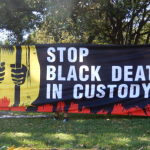The History of Murder: The Most Serious Offence in Criminal Law

Since the beginning of recorded law, the offence of murder has been seen as the most serious of crimes, with the intentional taking of another’s life considered at least as heinous than any other human act.
Despite how seriously it is considered and the corresponding punishments, the fact is humans continue to kill other humans for a range of reasons, from hatred and jealousy, to political advantage, to greed and even pleasure.
So how many homicides happen each year? When did the first recorded murders occur? And what are some of the most notable regimes and incidents of murder throughout history?
A prevalent crime
Perhaps one of the most respected reports on murder and other acts of homicide is titled The Global Burden of Disease, which is contained in the medical journal, The Lancet.
The report suggests that in 2019, in excess of 400,000 people died by homicide worldwide, which equates to approximately three times all combined deaths from armed conflict and terrorism.
Similar statistics have also been published by the World Health Organisation (WHO), but the Lancet peer reviewed publication of 2020 and endorsed by modelling of other even more recent statistics involving other global agencies.
This includes data sources, such as the United Nations Office on Drugs and Crime (UNODC) and the international homicide statistics gathered by the Institute for Health Metrics and Evaluation (IHME), which is a global health research centre at the University of Washington analysing amongst other things, death, including by murder.
So, lets go through the history of selected cases of murder.
First case of murder on earth
It is generally accepted by both the Christian and Islamic religions that the first murder was committed by Cain who killed his brother Able, with the motive being jealously, due to God accepting Abel’s sacrifice and rejecting Cain’s.
Though, the names of the brothers were Habil, whose sacrifice was accepted by Allah, leading to his murder by his brother, Qabil, in a fit of jealous rage.
Ancient serial murderers
5000 BC at a southern Germany stone age archaeological site in the municipality of Herxheim, a mass burial pit was excavated. The bones of about 500 butchered people, ranging from babies to aged citizens were discovered. Signs of cannibalism were evident.
Once again, such is the hypothesis debates which exists within the archaeological world, conjecture remains that it may also have been a commercial mortuary.
Named the Herxheim cannibalism, evidence showed that some of the deceased had been slow-roasted and that their skulls had been turned into bowls, with it apparent that the deceased had been eaten.
Ancient Rome 331 BC, mostly men started dying, seemingly from some sort of plague. Called patricians, the dead were all from the upper echelons of society. Whilst the Roman Senate believed it may have been the work of the Gods, a slave girl spilled the beans so to speak, in return for immunity from prosecution.
It was a cult of sorts, of 200 high society women, led by 2 aristocratic matrons, Sergia and Cornelia, who were poisoning mostly men.
Ancient historian, Professor Richard Bauman said his theory was that it appeared the women were protesting against what was arranged Roman marriages at that time, though this was contradicted by another historian, Dr Edith Lister who claimed it was a serious strain of influenza which was killing off the men, some of whom were the husbands of the women making the potion.
On being confronted at trial, Sergia and Cornelia drank their potion, thus appearing to commit suicide. Not so said Dr Lister, who suggested that the potion had one specific ingredient called hemlock, which in the wrong dosage, may lead to death from a lack of oxygen.
Patrician, originated from the Latin term patres or patricius signifying fathers, which were the privileged class of the Roman Empire.
Normal Romans were called plebeians.
Roman Empire
Back to the Roman Empire during the first century, another woman poisoner, Locusta, more adept as she was a skilled botanist and herbalist, apparently murdered her victims for fun.
Her modus operandi was to give her victims fatal heart attacks.
Emperor Nero would send his aspiring assassins to her for training. It was even alleged that she participated in the killing of Claudius and Britannicus, though no cogent evidence seems to exist of this.
Locusta was eventually executed and was regarded as the first serial murderer in Western history, though this is somewhat contested from various sources.
French serial murderer
Joan of Arc’s fighting companion, French nobleman, Baron Gilles de Rais, on his retirement from the military wished to become rich and therefore experimented in the occult and alchemy, endeavouring to make contact with a demon, in essence, endeavouring to make contact with the devil.
He began murdering children and on being apprehended, confessed to the murder of 140 young people and was hanged.
That was at least one version of the story.
Another version is that similar to what happened to Joan of Arc, the trial and conviction was an act of corruption by the Catholic church and like Joan of Arc, Baron de Rais was convicted amongst other crimes, of heresy.
It appears that Baron de Rais fell foul of the Catholic church, when in 1440 he kidnapped a priest and faced the might of the church.
It is most interesting that the Baron’s chief prosecutor, the Baron of Brittany, received all of Baron de Rais land and homes after his conviction.
Baby farmer nurse who murdered over 400 babies
1869 was the year widow Amelia Dyer, a trained nurse opened a baby farm, which is a place where unwanted children could be adopted for a fee. This was legal under the Poor Law Amendment Act of 1834.
Instead of feeding them and preparing the babies for adoption, the nurse strangled the children and disposed of their bodies in the River Thames in London.
Conjecture features on her first arrest, as she only received a 6-month sentence, casting aspersions on the system at that time, however as time went on, she continued her murderous spree, finally resulting in her demise, being hanged in 1896 at Newgate prison, by the hangman, James Billington.
The American pharmacist, who built a murder castle, Herman Webster Mudgett, alias H.H. Holmes, in 1893, which was originally an inn that he added a torture chamber, equipping the rooms with trapdoors, peeping holes, gas lines, soundproof padding and secret passages.
There was a chute leading to the basement, where he had installed a surgical operating table, a furnace and a medieval rack.
He lured many young women to his castle, where he murdered them by poison gas, then skinned them and sold their skeletons to medical schools, disposing of the remains in the furnace.
He was hanged in 1896, having killed more than 30 people.
Doctor Death
Popular British physician, Dr Harold Shipman, married family man, murdered over 200 of his patients, commencing in 1972.
It was 27 years later that he would be brought undone and sentenced to life imprisonment in 2000, where he committed suicide 4 years later.
One of the people who brought him to justice was the daughter of a patient he had murdered, a lawyer by profession.
Ancient cold cases
Los Angeles, USA, the La Brea tar pits are a series of asphalt pits where for in excess of 40,000 years, claimed many victims, such as imperial mammoths, saber tooth tigers and who is known as La Brea woman, who was excavated in 1914.
La Brea woman lived over 9,000 years ago and was perhaps California’s first murder victim.
Whilst some historians counter the murder allegation, as dog bones found next to her may also indicate a beloved burial. However, her wounds are consistent with foul play.
Fast forward
County Meath, Ireland in 2003, saw the excavation of who is known as the Clonycavan man, who was clearly murdered and disposed of in a peat bog, which because of its chemical composition, mummifies bodies, due to the cold, acidic and oxygen free environment preventing bacterial growth.
His injuries were consistent with having been murdered.
Radiocarbon dating places him having lived and died between 392 and 201 BC, which was around Western Europe’s iron age.
The first recorded case of murder, however, appears to be the find by archaeologists in Simos de los Huesos in Northern Spain, who concluded that the skull revealed evidence that the primitive man had been struck twice and died from two blows to the head.
The cave system is known as the Pit of Bones and is regarded as a rich source of prehistoric fossils, with the primitive human being having been killed approximately 400,000 years ago.
The skull was reconstructed after being found in an underground cave system, which contained the remains of 28 humans and took 20 years to locate enough fragments to enable reconstruction of 17 skulls.
Medical by-product of good and bad legacy of interbreeding of neanderthal and modern humans:
Whilst legacy genes have been linked to diabetes and cancer, other genes inherited from prehistoric life, potentially enhanced our immune system.
Sydney Australia’s First Nations Aboriginal
2005 saw Australia’s earliest cultural spearing victim, encouraging scientists from all associated fields to come together to endeavour to solve this cold case.
Believed to have been murdered about 4,000 years ago, the scientists couldn’t find enough to assert who may have murdered the man who was in his 30s and had lived on a diet of seafood, coastal birds and seaweed.
Aboriginal tribal punishment – payback
Spearing was a customary Australian Aboriginal sentence for the committing of crimes. The severity of the spearing was determined by the level of crime committed and varied from a wound to the leg, though pre-colonisation, it included a sentence of death.
Many historian scientists suggest it continued after colonisation also.
From Sydney to London and the butler didn’t do it, but the maid did
Maid, Marie Manning and her husband murdered Marie’s lover with the motive being money.
1849 was the year that Marie and her husband, Frederick Manning lured the victim, Patrick O’Connor to dinner, shooting him in the head and burying him under the kitchen floor.
Sentenced to death, Charles Dickens was inspired by the jeering mob at their public execution, to write his famous play, Bleak House.
Reviled Australian murderers
Under British rule, what was to become Tasmania, was initially part of the colony of New South Wales, until it became Van Diemen’s Land in 1825, when British convict, Thomas Jefferies murdered 6 people.
One of the victims was a baby and a police officer. Jefferies was hanged for his crimes.
New South Wales Belanglo State Forest was the burial ground of Ivan Milat, who murdered 5 women and two men who were backpackers from the United Kingdom and Germany.
Milat died of cancer in prison in 1994.
Sydney, New South Wales, affluent harbourside Mosman, saw Four’n Twenty pie salesman, known as the granny killer, John Wayne Glover, murder 6 elderly women. Sentenced to multiple life sentences, he committed suicide in prison in 2005.
William MacDonald, designated Australia’s first serial killer, MacDonald murdered and defiled the bodies of 5 men, 4 of them in Sydney, NSW in the early 1960s.
He died at age 90, also claiming the title of Australia’s longest serving prisoner.
John Bunting and Robert Wagner, with co-accused, Mark Haydon and James Vlassakis, murdered 11 people over 7 years in Snowtown, South Australia.
Bunting and Wagner are serving multiple life sentences, whilst Haydon and Vlassakis are serving decades in jail.
These are just several of many heinous serial murderers in Australia, with upcoming SCL articles focussing on other categories of Australian murders.
There are many of what are called cold cases in Australia, still being investigated, waiting for that all important piece of evidence or new technological advancements to bring the perpetrators to justice; and importantly, allow some semblance of peace to families by being able to put their loved one to rest in a dignified manner.
Recent Australian murders
The Australian Institute of Criminology (AIC) say that homicide in Australia in 2019-20 saw 278 victims, the highest number of homicide incidents in 15 years.
NSW had the most murders with 85, followed by Victoria with 66
The statistics were gathered by Australia’s only national data collection on homicide incidents, victims and offenders, the National Homicide Monitoring Program (NHMP).
The Australian Bureau of Statistics report that there were 193 murders in Australia in 2021, with 81 victims of homicide and related offences in NSW, a decrease of 18 victims from 2020.
63 NSW victims were male, with 48 knowing the perpetrator and 26 of them involving family domestic violence. A weapon was involved in 75% of cases.
The Australian Broadcasting Corporation and Mamamia report that 50 women were murdered in Australia in 2022, naming each victim.
Mamamia is Australia’s largest women’s media company, with an audience of 5 million Australian women.
Statistics were supplied by destroy the joint, an online feminist group founded in 2012 by Jenna Price, a Sydney Morning Herald writer.
Media reporting on recent Australian murders
Late last year saw two men, one a former Victorian police officer, remanded in custody over a cold case murder 16 years ago.
About the same time, the Brisbane Supreme Court has reserved a decision on the sentencing of a wife who fatally stabbed her abusive husband and pleaded guilty to manslaughter.
At a similar time, 2 boys appeared at a Brisbane children’s court, charged with fatally stabbing a mum in a home invasion.
Mid 2022 saw 2 men charged in a Queensland court with the murder of a Queensland man.
Australia is awaiting a decision of an Indian magistrate on the extradition of a suspect in the killing of a Queensland woman.
Finally, about a fortnight ago, a woman was charged with the murder of a father and daughter in Queensland.
This past week, a Perth court has remanded 3 more people charged with the bashing murder of an Indigenous teenager as he walked home from school.
Last week, a Sydney man was charged over the stabbing murder of his step-grandfather.
Early January 2023, a man was remanded in custody, charged with murdering his partner in NSW.
Again, approximately a week ago, a man appeared in a Penrith court, charged with the murder of his partner.
It appears that murderers don’t have a break.
We discussed earlier how criminal anthropology, forensic archaeology and genome-wide analysis come together to assist in bringing their special skills to the pursuit of justice.
Well, without such expertise, crime fighting departments wouldn’t have the success they have, nor would NSW have the FETSC.
Forensic evidence and technical services command (FETSC)
This NSW division has in excess of 900 police personnel and civilian staff to ensure that high quality forensic services assist investigations, prevent and disrupt crime, protect the community and serve the justice system.
These capabilities include:
- Collection and analysis of physical and electronic evidence at crime and incident scenes.
- Scientific analysis, interpretation of evidence and presentation of evidence to court.
- Identification of persons through biometric means, fingerprints and DNA to assist in criminal, incident and coronial investigations.
- Identification of persons through criminal history to provide background information to the court to inform decisions.
- Criminal record and fingerprint-based background checking to assist in placing the right persons in the right places for specific jobs , visas, adoptions to name a few.
- Provision of forensic intelligence to assist solving crime across boundaries; linking crime across different evidence types.
- Provision of advice and logistical support to the NSW Police response to chemical, biological, radiological, nuclear and explosive incidents and disaster victim identification events.
- Facilitation of targeted research and innovative development opportunities in collaboration with other forensic and educational institutions.
Criminal anthropology
Anthropological criminology has the expertise required to assess age, sex and unusual features of a person and capable of documenting trauma and decomposition, amongst many other aspects.
Forensic archaeology:
This science uses archaeological skills to help with the discovery and recovery of human remains.
Genome-wide analysis
Allows scientists to identify genes associated with a particular trait or disease. In essence, the study of DNA of a large group of people, searching for small variations, which may lead to relevant findings in relation to antisocial behaviours involving psychology.
Crime fighting techniques have certainly come a long way from Mr Plod, hello, hello sir!
The offence of murder in New South Wales
Murder is an offence under section 18 of the Crimes Act 1900 which carries a maximum penalty of life imprisonment.
To establish the offence, the prosecution must prove beyond reasonable doubt that the defendant:
- Caused the death of another person,
- Did so by way of a voluntary act or omission,
- Did so with the intention to kill or inflict grievous bodily harm, or with reckless indifference to human life, or during or immediately after the commission of an offence punishable by a maximum penalty of 25 years in prison (constructive murder).
Causation
An act or omission is considered to have ‘caused the death’ of another if it was a ‘substantial or significant caused’ of the death, even if some other cause was also operating at the time.
An act or omission will have caused death unless there is a break in the chain of causation, which will only occur if the original injury is merely the setting in which the subsequent cause operates, or if the subsequent cause is so overwhelming that it significantly diminishes the relevance of the original cause.
Examples of where the chain of causation is not broken include:
- Where the victim refuses medical treatment on religious grounds,
- Where subsequent medical treatment is poor, unless the injury had almost healed, and
- Where the victim engaged in unconscious acts that led to death.
The prosecution must prove causation, and a defendant is entitled to an acquittal if the prosecution fails to do so.
For example, a defendant was found not guilty in a case where the prosecution was unable to disprove that an underlying disease was the cause of the complainant’s death.
Voluntary act or omission
The defendant’s act or omission must be voluntary, and automatism (acting unconsciously) is a defence to murder.
So, for example, a person must be found not guilty if they commit the act while ‘sleepwalking’ in the absence of self awareness and self control.
Intention to kill or cause grievous bodily harm
An intention to kill or cause grievous bodily harm (GBH) means that at the time the defendant engaged in the subject act or omission, he or she meant to kill or cause GBH to the victim.
GBH means ‘very serious harm’, and includes but is not limited to:
- Any permanent or serious disfigurement,
- The destruction of a foetus, other than by a medical procedure, and
- Any grievous bodily disease.
The required intent may be established where:
- A continuous course of events led to the victim’s death, and the defendant meant to kill or cause GBH at any time during those events,
- The defendant meant to kill or cause GBH but genuinely believed his or her actions would not lead to that outcome, or
- The defendant meant to kill or cause GBH to a particular person but instead caused the death of a bystander.
Reckless indifference to human life
A defendant is recklessly indifferent if he or she did, or omitted to do, an act foreseeing that death would be the probable result.
Constructive murder
Constructive murder, sometimes called ‘felony murder’, is where another person’s death occurred during or immediately after the defendant or an accomplice committed, or attempted to commit, a criminal offence punishable by a maximum penalty of at least 25 years in prison.
Such offences include:
- Robbery while armed with a dangerous weapon,
- Robbery with wounding, and
- Sexual intercourse with a child under 10 years.
Penalty for murder
Section 19A of the Crimes Act 1900 prescribes a maximum penalty of life imprisonment for the offence of murder, and it is important to be aware that in New South Wales life imprisonment means ‘for the term of a person’s natural life’.
Standard non parole periods
Murder offences also carry what’s known as ‘standard non parole periods’ (SNPP), which are guideposts of reference points for a sentencing judge when determining the minimum term a person must spend behind bars before he or she is eligible to apply for release on parole.
The SNPPs for murder are:
| Murder — of a police officer, emergency services worker, correctional officer, judicial officer, council law enforcement officer, health worker, teacher, community worker, or other public official, exercising public or community functions and the offence arose because of the victim’s occupation or voluntary work | 25 years |
| Murder — where the victim was a child under 18 years of age | 25 years |
| Murder — in other cases | 20 years |
Defences to murder
Self defence is the most common defence to murder.
The defence is contained in section 418 of the Crimes Act 1900, which states that a person is not criminally responsible if he or she believes the actions were carried out in self-defence, and the conduct is a reasonable response to the perceived circumstances.
Self-defence is a complete defence, which means the person is entitled to be found not guilty for their actions.
The defence is available where the conduct is necessary to:
(a) defend oneself or another person, or
(b) prevent or terminate the unlawful deprivation of ones liberty or the liberty of another person, or
(c) protect property from unlawful taking, destruction, damage or interference, or
(d) prevent criminal trespass to any land or premises or to remove a person committing any such criminal trespass.
This extends to situations where a person steps in to defend another person.
However, section 420 of the Act makes clear that self-defence is not available where a person uses force that involves the intentional or reckless infliction of death only to protect property or prevent a trespass.
And section 421 provides that where a person uses excessive force to defend themselves or another, including to prevent the unlawful deprivation of liberty, and that force results in their target’s death, the person will be criminally responsible for manslaughter rather than murder provided that he or she believed the conduct was necessary in the circumstances.
Significantly, section 419 stipulates that if evidence of self-defence is raised, the prosecution must then prove beyond a reasonable doubt that the actions did not amount to self-defence. If the prosecution is unable to do this, the defendant must be acquitted.
As mentioned above, automatism is also a defence to murder.
Charged with murder?
If you or a loved-one has been accused of murder, call Sydney Criminal Lawyers anytime on (02) 9261 8881 to arrange for a conference or prison visit with a defence lawyer who is vastly experienced in advising and representing clients in serious criminal cases, including murder and manslaughter.






